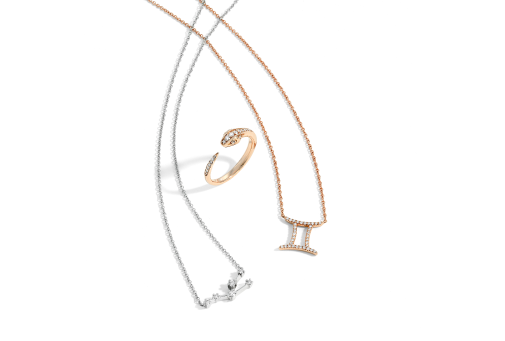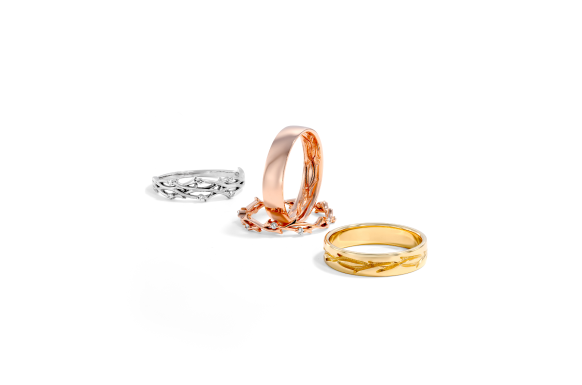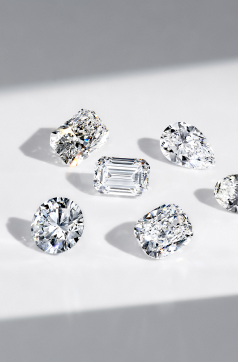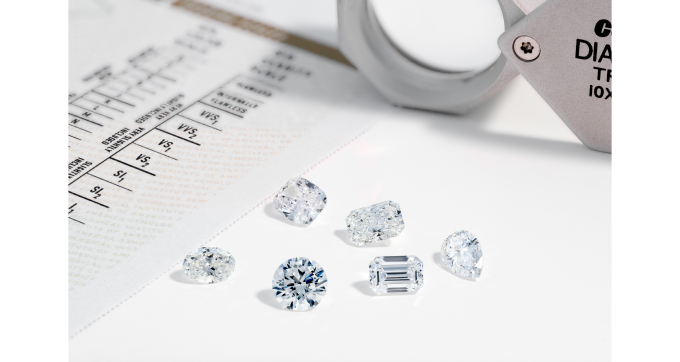Moissanite Colors
Education Center
Education CenterEverything You Need to Know About Moissanite Colors
For over three decades, the clarity and brilliance of Moissanite have made it a discerning choice for couples who desire an enduring symbol of their union. Like diamonds, the characteristics of individual Moissanite stones can vary, with Moissanite color being a key characteristic to evaluate.
In this guide, we explain the essentials of Moissanite color to assist you in your search for an outstanding engagement ring.
Does Moissanite have a color?
The physical and optical properties of naturally occurring and synthetically produced Moissanite stones have long been regarded for their close similarity to diamond including the presence of color. Natural Moissanite is often found as inclusions within natural diamonds and can be subject to the same thermal, baric, and chemical conditions that produce colored stones. Synthetic Moissanite gemstones can also possess discernible color in shades that include:
- Blue
- Yellow
- Brown
- Green
Most Moissanite stones are colorless with subtle shades of yellow and brown.
What gives Moissanite stones their color?
Moissanite stones acquire color through the synthetic process they undergo. These gems are created under extreme conditions, with superheated and pressurized gasses condensing to form the stone within special sealed chambers. The presence of trace elements including nitrogen, sulfur, and boron leads to unintended interactions with carbon in the stone that leave a tint.
Grading color in Moissanite stones
Though there isn't a formal grading framework for Moissanite, the 4Cs of the Gemological Institute of America (GIA) are often informally applied to appraise loose Moissanite stones. Laboratory-standard color grading follows a strict protocol that specifies the lighting, background, and handling of a stone. The gems are usually compared to masterstones with known color to determine their grade.
Here is the grading of Moissanite color
On the industry-wide D-to-Z grading scale, normal Moissanite stones will have one of the following grades:
1. Colorless Moissanite stones are graded D-E-F.
2. Near-colorless Moissanite stones are graded G-H-I.
3. Slightly tinted Moissanite stones are graded J-K.
As you progress through the alphabetical grading scale, the Moissanite color becomes more yellow or brown.
Fancy Moissanite colors
Colorless Moissanite is known as white Moissanite but Moissanite stones that have a level of color that is beyond the D-to-Z range are known as fancy color Moissanite. The color can spontaneously occur as part of the gem's synthetic process or be deliberately applied. These colored synthetic diamonds exhibit bright or extremely dark colors that include pinks, blues, greens, and reds.
Fancy Moissanite grading
The strength and purity of the color vary, with grades of fancy stone that reflect the intensity of color: Fancy Moissanite grades range from faint, through to fancy intense, fancy vivid, fancy dar, and fancy deep.
How does Moissanite color affect value?
Moissanite color is a key determinant of the value of these gemstones. The most valuable Moissanite stones are colorless (grade D-E-F) and their value decreases as the color becomes stronger. For some couples, an inclusion or blemish-free stone that has a near-colorless grade or even slight tinting may be a cost-effect way of owning a beautiful stone that is known for its brilliance. Conversely, for fancy color Moissanite, the presence and depth of color increase the value of the stone. High-quality, vivid and deep stones are less common and, of course, more desirable.
Engagement ring Moissanite color
A Moissanite stone will delight its wearer with its ability to split light into a kaleidoscope of color. These superb optical properties mean that even near-colorless or tinted Moissanite will create a breathtaking display. Here are some tips for selecting your perfect Moissanite stone:
Moissanite cut and clarity
Our expert lapidaries and jewelers select and cut Moissanite for exceptional brilliance, so irrespective of color, choose your Moissanite stone for its cut and clarity.
Moissanite carat size
Large simulated diamonds like Moissanite can have yellow or green tinting present that becomes prominent in certain light. This is usually more noticeable when the stone is more than one carat in weight.
Moissanite setting
Your choice of metal and setting can counteract any tinting or color in your Moissanite stone. If the color grade of your Moissanite is low, pair your stone with rose or yellow gold and make the gem appear whiter and stand out more. You can also experiment with settings that will flatter a colored stone like the halo or hidden-halo setting. For couples that select a multi-stone ring, select accent diamonds that are similar in color to the center stone to ensure that it owns all of the attention.
Conclusion
The fire and luster of Moissanite make these precious stones a joy to wear. By understanding the color grading of these stones, you can select loose stones or a ring that delivers not only exceptional beauty but also an outstanding value. Browse our extensive selection of the highest-grade Moissanite loose stones and engagement ring settings to find your perfect match.



